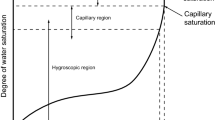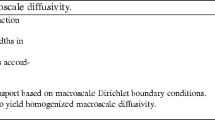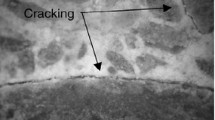Abstract
In this paper, a simple flow model for stimulating mass or heat transfer in heterogeneous materials like concrete is presented. The material is discretized as a regular triangular lattice. The lattice elements are considered as conductive “pipes”. A generated particle structure of concrete is projected on the lattice, where-after different properties are assigned to “pipes” falling in different phases of the composite. Drying of a two-phase composite was analyzed. It is assumed that all mass or heat transfer can be described by means of a single diffusion equation. The comparison with finite element computations is found to be very satisfactory. A parameter analysis has been carried out, showing the effective transport properties of the composite as a function of geometrical or physical properties of the different phases in the heterogeneous material. In particular, the model has been used to study the effect of the permeability of the interfacial transition zone and the effect of using non-saturated porous aggregates on the moisture flow in concrete.
Résumé
Dans cet article, nous présentons un modèle-réseau pour simuler le transfert de masse ou de chaleur dans des matériaux hétérogènes tel le béton. Un matériau composite est représenté par un réseau régulier de triangles équilatéraux. Le côté de chaque triangle est considéré comme étant un «tuyau” conducteur. Une structure réaliste de ce matériau est générée et projetée sur le réseau; on peut identifier ensuite les «tuyaux» appartenant aux différentes phases composant le matériau réel et leur assigner leurs propres caractéristiques physiques. Le processus de séchage d'une structure composite binaire a été ainsi analysé. Il a été supposé que tout transfert de masse ou de chaleur dans chaque phase est régi par une seule équation de la diffusion. La comparaison avec les calculs par la méthode des éléments finis s'avère être très satisfaisante. Une analyse paramétrique a été réalisée qui montre les coefficients de transferts effectifs du composite en fonction des propriétés géométriques et physiques des différentes phases du matériau hétérogène. En particulier, ce modèle a été utilisé pour étudier l'influence sur la diffusion hydrique d'un béton, de la perméabilité de la zone de transition interfaciale et l'utilisation des granulats poreux non-saturés.
Similar content being viewed by others
References
Sadouki, H. and Van Mier, J.G.M., ‘Simulation of hygral crack growth in concrete repair systems’,Mater. Struct. 30 (203) (1997) 518–526.
Schlangen, E. and Van Mier, J.G.M., ‘Experimental and numerical analysis of micro-mechanisms of fracture of cement-based composites’,Cem. & Conc. Composites,14 (1992) 105.
Quenard, D. and Sallee, H., ‘Water vapour adsorption and transfer in cement-based materials: a network simulation’,Mater. Struct. 5 (1992) 515.
DIANA, ‘Users manual-Release 6.1’ (Diana Analysis BV, Delft, The Netherlands, 1995).
Van Mier, J.G.M., Schlangen, E. and Vervuurt, A., ‘Lattice-type fracture models for concrete’, in ‘Continuum Models for Materials with Microstructure’, Mühlhaus, H.-B., Ed. (John Wiley & Sons Ltd., Chap. 10, 1995).
Walraven, J.C., ‘Aggregate interlock: A theoretical and experimental analysis’, Ph.D. thesis, Delft University of Technology, The Netherlands, 1980.
Roelfstra, P.E., Sadouki, H. and Wittmann, F. H., ‘Le béton numérique’,Mater. Struct. 18 (1985) 327.
Sadouki, H. and Wittmann, F.H., ‘Heat and gas transfer in a composite concrete-like material simulated by means of finite volume method’, 1st European Conf. Num. Meth. in Engrg., Brussels, Belgium, 1992.
Sadouki, H. and Wittmann, F.H., ‘Time-dependent temperature distribution in an heterogeneous material’, 9th Int'l. Congress on Chemistry of Cement, New Delhi, India, 1992.
Zhang, M.H. and Gjørv, O.E., ‘Microstructure of the interfacial zone between lightweight aggregate and cement paste’,Cem. & Conc. Res. 20 (1990) 610.
Author information
Authors and Affiliations
Additional information
Editorial note: Dr. Jan G. M. van Mier is a RILEM Senior Member. He is Secretary of TC 148-SSC on Test methods for the Strain Softening responses of Concrete and a member of TC 159-ETC on Engineering of the interfacial Transition zone in Cementitious composites. In 1987, Dr. van Mier was awarded the Robert L'Hermite Medal for outstanding research work. Dr. van Mier is also a member of the RILEM Management Advisory Committee. Dr. van Mier is the RILEM National Delegate for The Netherlands.
Rights and permissions
About this article
Cite this article
Sadouki, H., van Mier, J.G.M. Meso-level analysis of moisture flow in cement composites using a lattice-type approach. Mat. Struct. 30, 579–587 (1997). https://doi.org/10.1007/BF02486899
Received:
Accepted:
Issue Date:
DOI: https://doi.org/10.1007/BF02486899




